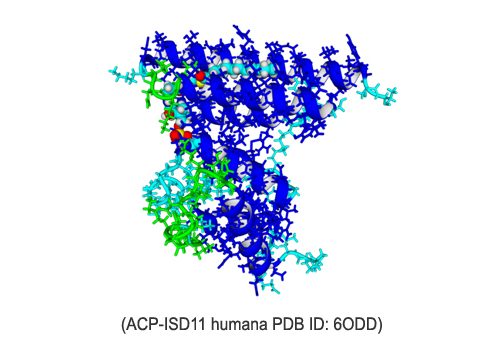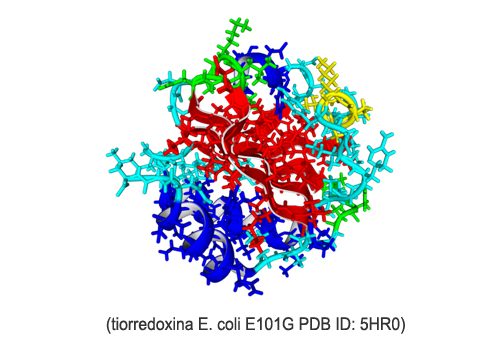Summary
Our laboratory investigates the structural and functional dynamics of proteins associated with rare diseases of interest to human health. We aim to understand the relationships between biological function, activity, stability, and dynamics of these proteins.
Lines of research
We focus on studying the proteins that constitute the human mitochondrial iron-sulfur cluster synthesis supercomplex: NFS1, ISD11, ACP, ISCU, FXN, FDX2, and FdxR. We develop specific chaperone proteins based on nanobodies and affitins as a strategy to stabilize unstable variants in their active conformations. We investigate the biophysical properties of the generated chaperone proteins (affitins, nanobodies, and peptides) and their interactions with target proteins. Additionally, we examine the biological effects of applying chaperone proteins to patient cells and assess the resulting changes in cellular phenotype.
We study the transactive response DNA-binding protein 43 (TDP-43), which plays a critical role in RNA physiology and forms cytoplasmic aggregates in patients with Amyotrophic Lateral Sclerosis (ALS). We employ a comprehensive experimental approach, incorporating both in vitro and in vivo techniques, to investigate the relationships between stability, protein-protein interactions, protein-RNA interactions, and the biological function of this protein. Additionally, we utilize computational tools to gain deeper insights into these processes.
Firstly, we aim to advance the understanding of the structure-function relationship of modular RNA-binding proteins by studying the structural domains of FMRP and FMR2. A detailed structural analysis of these two RNA-binding proteins is crucial for elucidating their molecular biological functions. This research will identify the molecular bases of their specific recognition of target RNAs and the subsequent processing of these RNAs through interactions with other RNA-binding proteins. This knowledge will ultimately help us understand how deficiencies in these proteins lead to intellectual disabilities and reveal potential targets for therapeutic intervention.
Secondly, we seek to gain a detailed understanding of the mechanism of action of the KH domains found in FMRP and many other proteins, as well as the reasons for their frequent occurrence in various RNA-binding proteins. Structural studies of these domains will address broader questions about how proteins evolve and adapt their structures over time.
Fanconi anemia is a rare autosomal recessive disorder, occurring in approximately 1 in 350,000 individuals. At the molecular level, over twenty proteins involved in the FA/BRCA pathway work together to maintain genome integrity by repairing DNA cross-links. Pathogenic variants in these proteins disrupt the DNA repair system, leading to chromosomal abnormalities.
In our laboratory, we are focused on producing FANCF in its Trojan form and correctly folded, with the goal of assessing its administration to human cells and evaluating the potential reversal of the associated phenotypes.
Fanconi anemia (FA) is a rare autosomal recessive disorder, occurring in approximately 1 in 350,000 individuals. At the molecular level, more than twenty proteins involved in the FA/BRCA pathway work together to maintain genomic integrity by repairing DNA cross-links.
In our research group, we focus on the FANCF protein. We are producing a Trojan variant of FANCF and will evaluate its conformational state and ability to penetrate eukaryotic cells. Additionally, we will analyze the phenotypic rescue in cells deficient in this protein.
This project is based on the production and biophysical characterization of Trojan fragments of the Sacsin protein, designed to study protein stability and the specific functional characteristics of this protein within the cellular environment. The Trojan fragments will be able to penetrate human cells; this provides an opportunity to investigate the stability of the fragments in a biological setting and the function of protein modules independent of protein translation. These experiments will be conducted in parallel with the study of cellular transfection using expression vectors that encode the same Sacsin fragments. The investigation of Trojan fragments could enhance the understanding of the structural modules of Sacsin independently from the protein translation process, thus avoiding co-translational protein degradation.
Colaborations:
Dra. Celia Quijano y Dra. Laura Castro.
Facultad de Medicina Universidad de la República, Montevideo, Uruguay
Dr. Juan Antonio Hermoso y Dr. Rafael Molina
Departmentamento de Cristalografía y Biología Estructural. Insituto de Fisicoquímica Blas Cabrera Consejo Nacional de Investigaciones espaInstitute of Physical Chemistry Blas Cabrera. Consejo Superior de Investigaciones Científicas (CSIC). Madrid, España.
Dra. Paola Costantini
Departamento de Biología, Universidad Nacional de Padova, Padova, Italia.
Members:
Maria Florencia Pignataro
mariaflorenciapignataro@gmail.com
Postdoctoral fellow (F.A.R.A)
Hernan Gustavo Gentili
hergus77@gmail.com
Postdoctoral fellow (ANPCyT)
Augusto Emanuel García
augustoemanuel95@gmail.com
PhD fellow (UBACyT / NEB)
Alvaro Moreno
Undergraduate student
Naira Rodríguez
Undergraduate student
María Georgina Herrera
geor.herr@gmail.com
Assistant Scientist (CONICET)
Martín Ezequiel Noguera
mnoguera.unq@gmail.com
Assistant Scientist (CONICET)
Michelle Guarino
Undergraduate student
Lara Aguilar
Undergraduate student





